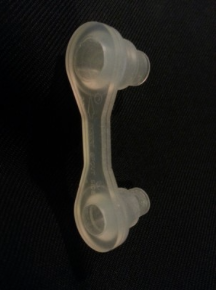I found the following article on Wikipedia and immediately realized the correlation between homeostasis in the scientific world and sustainable success in the business world. I found it very interesting to "edit" the piece by (inserting applicable terms) which serve as viable substitutions to the words preceding them.
For another coherent piece, one might also substitute familial terms along with principles of: love, discipline, respect and education respectively as these scientific concepts are universally sound across every family, school and business that is, at it's core, a small branch of the greater natural world in which we live.
HOMEOSTASIS-
"In simple terms, it is a process in which the body's internal environment is kept stable, despite changes in external conditions. The concept was described by Claude Bernarrd as Multiple dynamic equilibrium adjustment and regulation mechanisms make homeostasis possible."
With regard to any given life system (business) an organism (employee) may be a conformer or a regulator.
Regulators (managers) try to maintain parameters at a constant level over possibly wide ambient environmental variations.
Conformers (smart hires) allow the environment to determine their parameters (buy in).
For instance endothermic animals, namely mammals and birds(successful managers) maintain a constant body temperature (standard), while ectothermic animals, namely almost all other organisms (non-managent)unless acted upon may exhibit wide body temperature (behavioral) variation.
Behavioral adaptations (engaged managers) allow ectothermic animals (non-managent) to exert some control over a given parameter.
For instance, reptiles (unsatisfied employees) often rest on sun-heated rocks (strong leaders) in the morning to raise their body temperature (morale, performance or perception).
Regulators (Management) are also responsive to external circumstances (customers, market fluxtuation, demand, competition, etc..), however: if the same sun-baked boulder (motivational leader) happens to host a ground squirrel (colleague / employee requiring less motivation) , the animal's metabolism (colleague's moral, performance, perception, etc...) will adjust to the lesser need for internal heat production (motivation) .[citation needed]
An advantage of homeostatic regulation (effective management) is that it allows an organism (business) to function effectively in a broad range of environmental conditions. For example,ectotherms( non-management employees) tend to become sluggish at low temperatures (when business is slow), whereas a co-located endotherm (manager) may be fully active. That thermal stability comes at a price (higher salary and benefits) since an automatic regulation system (keeping your head when all others about you are losing theirs...) requires additional energy.
All homeostatic control mechanisms (Successful Systems of Operation) have at least three interdependent components for the variable being regulated: The receptor is the sensing component that monitors and responds to changes in the environment (executives / general managers). When the receptor senses a stimulus (performance), it sends information to a "control center", the component that sets the range at which a variable is maintained (board of directors / ownership) The control center (board) determines an appropriate response to the stimulus (performance). In most homeostatic mechanisms, the control center is the brain. The control center then sends signals to effectors (mid-level management), which can be muscles, organs or other structures that receive signals from the receptors (general manager) or control center (directors). After receiving the signal, a change occurs to correct the deviation by either enhancing it with positive feedback or depressing it with negative feedback.[10]
Positive Feedback:
Mechanisms (praise) designed to accelerate or enhance the output created by a stimulus (successful performance) that has already been activated (achieved).
Unlike negative feedback mechanisms that initiate to maintain or regulate (critique / correct) physiological functions within a set and narrow range (underperformance), the positive feedback mechanisms are designed to push levels out of normal ranges (motivate by positive reinforcement).
To achieve this effect, a series of events initiates a cascading process (appreciation and engagement) that builds to increase the effect of the stimulus (performance). This process can be beneficial but is rarely used by the body due to risks of the acceleration's (unwarranted praise/ reward or unnecessary expenses) benefit being diluted.
One positive feedback example event in the body is blood platelet accumulation, which, in turn, causesblood clotting in response to a break or tear in the lining of blood vessels. Another example is the release of oxytocin to intensify the contractions that take place during childbirth.[10]
Negative feedback:
Negative feedback mechanisms consist of reducing the output activity (limiting privileges or offering constructive criticism) of any organ (employee with opportunity to improve) or system (many) back to its normal range of functioning (procedure).
A good example of this is regulating blood pressure. Blood vessels can sense resistance of blood flow against the walls when blood pressure increases. The blood vessels act as the receptors and they relay this message to the brain. The brain then sends a message to the heart and blood vessels, both of which are the effectors. The heart rate would decrease as the blood vessels increase in diameter (known as vasodilation). This change would cause the blood pressure to fall back to its normal range. The opposite would happen when blood pressure decreases, and would cause vasoconstriction.
Another important example is seen when the body is deprived of food. The body would then reset the metabolic set point to a lower than normal value. This would allow the body to continue to function, at a slower rate, even though the body is starving. Therefore, people who deprive themselves of food while trying to lose weight would find it easy to shed weight initially and much harder to lose more after. This is due to the body readjusting itself to a lower metabolic set point to allow the body to survive with its low supply of energy. Exercise can change this effect by increasing the metabolic demand.
Both feedbacks are equally important for the healthy functioning of one's body...
Homeostatic imbalance:
Many diseases (business failures) a result of disturbance of homeostasis, a condition known as homeostatic imbalance (mismanagement). As it ages, every organism (business) will lose efficiency in its control systems(process management). The inefficiencies gradually result in an unstable internal environment (dymamics) that increases the risk for illness (losses). In addition, homeostatic imbalance(mismanagement) is also responsible for the physical changes associated with aging (obsolescence). Even more serious than illness (losses) and other characteristics of aging(inefficiency) is death(bankruptcy). Heart failure has been seen where nominal negative feedback mechanisms become overwhelmed, and destructive positive feedback mechanisms then take over.[10]Diseases(failures) that result from a homeostatic imbalance (mismanagement) include diabetes(inability to balance books), dehydration(lack of working capital), hypoglycemia(inability to drive sales), hyperglycemia (lack of infrastructure to handle volume), gout (disruptive employees), and any disease caused by a toxin present in the bloodstream (loss, theft, embezzlement).
All of these conditions result from the presence of an increased amount of a particular substance (problem). In ideal circumstances, homeostatic control mechanisms (successful management) should prevent this imbalance from occurring, but, in some people (organizations), the mechanisms (standard operating procedure, standard of care or systems of operation) do not work efficiently enough or the quantity of the substance (seriousness or lifespan of the problem) exceeds the levels at which it can be managed.
In these cases, medical intervention (outside consulting services) is necessary to restore the balance, or permanent damage to the organs (culture, mission, people power, etc...) may result.
According to the following citation, every illness has aspects to it that are a result of lost homeostasis (managent controls): "Just as we live in a constantly changing world, so do the cells and tissues (businesses) survive in a constantly changing microenvironment (marketplace). The 'normal' or 'physiologic' (profitable or sustainable) state then is achieved by adaptive responses to the ebb and flow of various stimuli (activity and performance) permitting the cells and tissues to adapt and to live in harmony within their microenvironment... Thus, homeostasis is preserved. What is good for individual cell is good for the entire system.
Varieties:
Author George Leonard discusses in his book "Mastery" how homeostasis affects our behavior and who we are. He states that homeostasis will prevent our body from making drastic changes and maintain stability in our lives even if it is detrimental to us.[12]Examples include when an obese person starts exercising, homeostasis in the body resists the activity to maintain stability.[13] Another example Leonard uses is an unstable family where the father has been a raging alcoholic and suddenly stops and the son starts up a drug habit to maintain stability in the family.
A note to other advisors, consultants, parents or anyone looking to champion a turn-around, Leonard also said: "Homeostasis is the main factor that stops people changing their habits because our bodies view change as dangerous unless it is very slow." Expect resistance and unnecessary delays if the need for change isn't first communicated and desired system-wide. Expect success if it is and you have the time and resources to walk them as opposed to pushing them through it.



